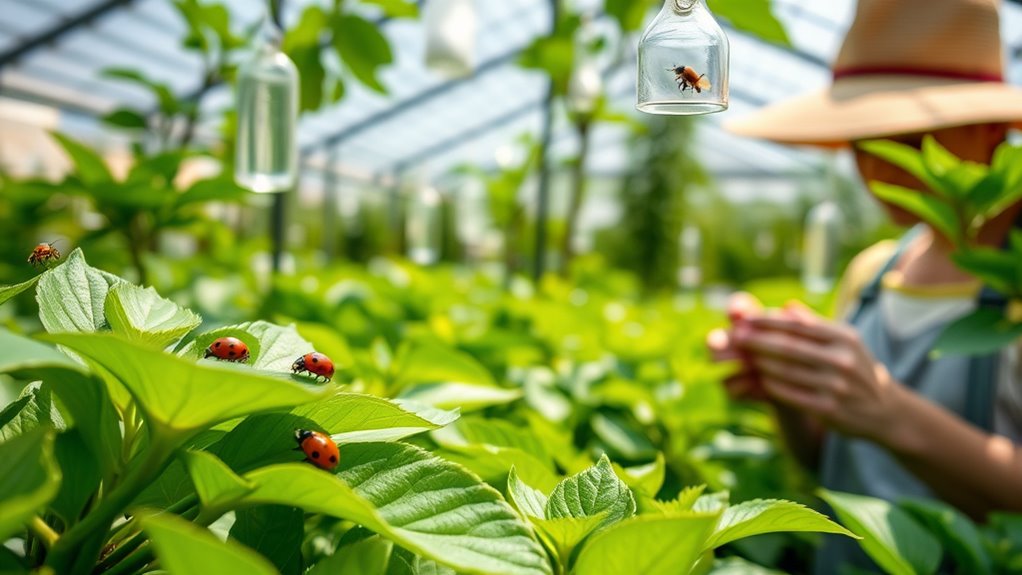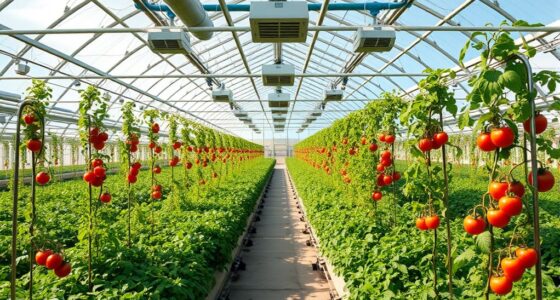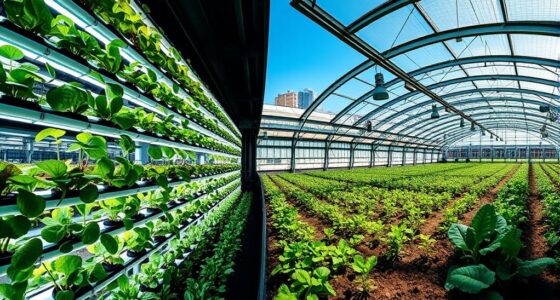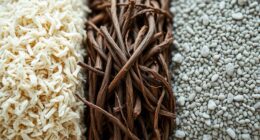To manage pests in your greenhouse, using Integrated Pest Management (IPM) is key. Start by understanding pest life cycles and employing cultural strategies, like crop rotation and maintaining sanitation. Incorporate biological controls, such as beneficial insects and essential oils, while also utilizing physical barriers like fine mesh screens. When necessary, apply targeted chemical methods wisely to minimize environmental impact. There’s much more to explore about effectively implementing and refining these strategies to keep your greenhouse thriving.
Key Takeaways
- Implement sanitation measures by removing weeds and debris to minimize pest attraction and infestation risks in greenhouses.
- Use crop rotation and fallow periods to disrupt pest life cycles and promote healthy plant growth.
- Introduce beneficial organisms and natural deterrents early to manage pest populations effectively without relying heavily on pesticides.
- Monitor and scout regularly to assess pest populations, plant health, and determine when action thresholds are met.
- Evaluate and refine IPM strategies continuously based on data analysis and feedback from pest management practices.
Understanding Integrated Pest Management (IPM)
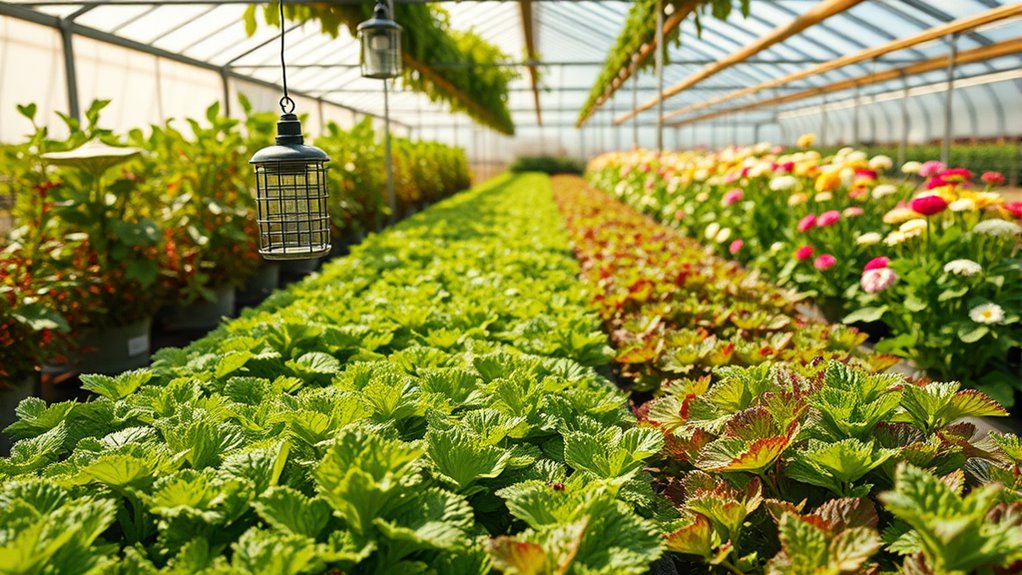
Integrated Pest Management (IPM) is a thorough approach to pest control that combines various techniques to minimize environmental disruption while effectively managing pest populations. By focusing on prevention through sanitation and exclusion, you can reduce the likelihood of pest problems in the first place. Understanding pest life cycles and their interactions with the environment enables you to manage damage more effectively. A clean greenhouse is essential for preventing pests and diseases from thriving. Implementing effective decluttering strategies can create a more organized and less attractive environment for pests. Additionally, choosing the right plants can naturally deter certain pests, contributing to a healthier greenhouse ecosystem.
Key components of IPM include monitoring and scouting to identify pest populations, accurate pest identification for tailored strategies, and record-keeping to track pest numbers and treatment success. Regular maintenance plans can help ensure that your greenhouse environment remains conducive for healthy plant growth while deterring pests. Setting action thresholds helps you determine when control measures are necessary, ensuring timely interventions that can include physical barriers, biological controls, and targeted chemical use as a last resort.
Cultural Pest Control Strategies
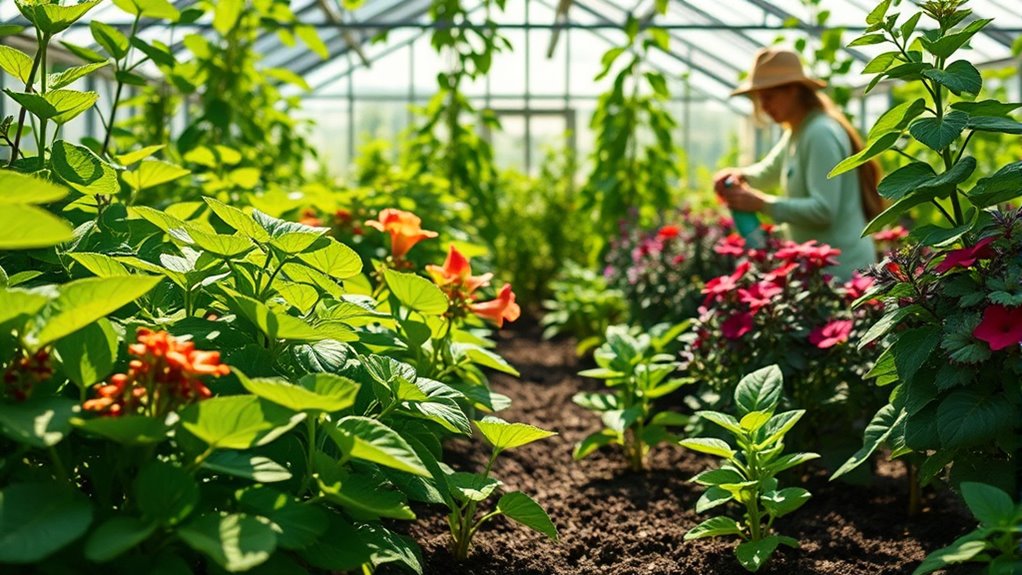
Effective pest management goes beyond just understanding pest life cycles; it involves implementing strategies that create an unfavorable environment for pests.
Start by managing environmental factors like light, temperature, and humidity to deter pests. Crop rotation and scheduling fallow periods disrupt pest life cycles by removing their food sources. Adjusting environmental factors is crucial as it can significantly affect plant health and pest prevalence. Implementing proper sanitation practices is also essential for minimizing pest attraction. Regularly monitoring for signs of illness in your plants can help identify potential pest problems early. Additionally, understanding the emotional dysregulation that can arise from pest infestations may help in addressing stress related to managing your greenhouse effectively.
Maintain sanitation practices by clearing weeds and debris to prevent pest habitation. Pruning and rouging affected plants helps contain infestations.
Design your greenhouse thoughtfully by separating facilities for different plants and implementing weed control measures.
Regular inspections and keeping detailed records allow you to monitor pest populations effectively.
Biological Control Methods
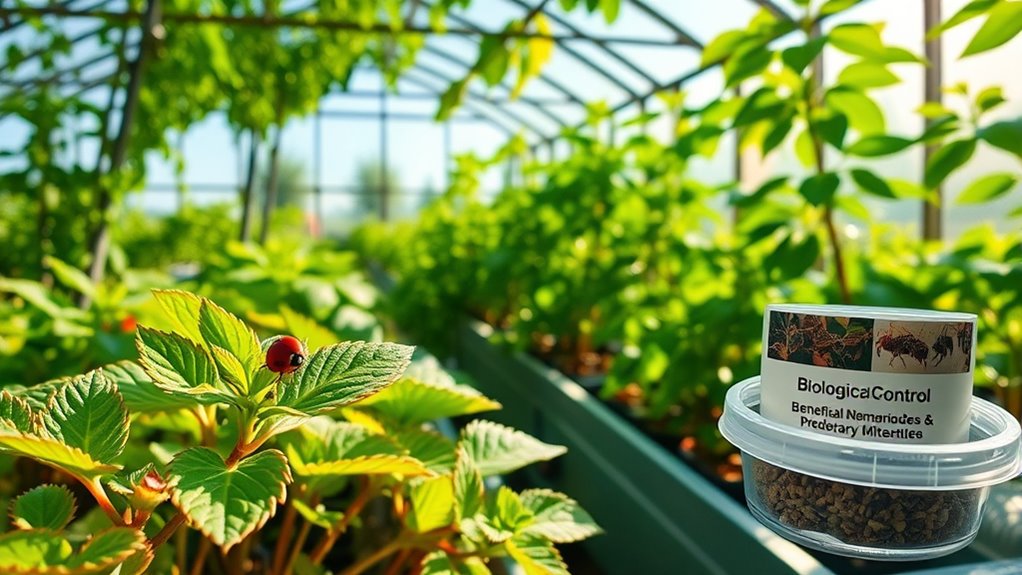
While traditional pest control methods often rely heavily on chemicals, biological control methods offer a sustainable alternative by harnessing nature’s own defenders.
By using beneficial organisms like predatory insects, parasitic insects, and microorganisms, you can effectively manage pest populations. These agents, such as lady beetles and predatory mites, can reduce your reliance on pesticides, although they may not eliminate pests entirely. Biological control typically does not eliminate target pests entirely, making it a complementary approach in pest management. Moreover, incorporating essential oils into your pest control regimen can provide additional natural deterrents. Additionally, fostering emotional intelligence can enhance your ability to identify and respond to pest issues more effectively. Understanding your risk tolerance in pest management strategies can also help you make informed decisions.
To maximize effectiveness, introduce these agents early, before pest populations explode. Keep in mind that these beneficial organisms can be sensitive to pesticides, so careful selection is essential.
Integrating biological control with other IPM strategies enhances its success, ensuring you maintain a healthy greenhouse environment while minimizing environmental impact.
Physical Pest Control Techniques
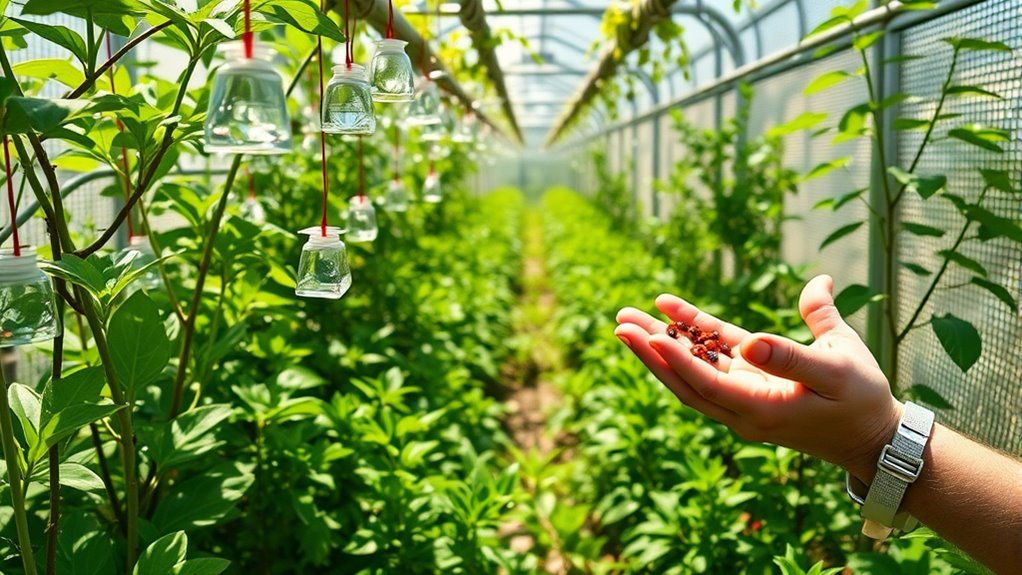
Physical pest control techniques are crucial for maintaining a healthy greenhouse environment. You can use fine mesh screens over ventilation openings to exclude insects like aphids and whiteflies, considerably reducing pesticide use. Additionally, incorporating high refresh rates in your pest control strategies can enhance your overall effectiveness in monitoring pest populations.
Consider employing traps with sticky surfaces for capturing pests or manually removing them by hand-picking. Vacuuming pests from plants is another effective option. Healthy plants are more resilient and can thrive in less-than-ideal conditions, which emphasizes the importance of maintaining plant health. Additionally, a clean environment supports a healthier lifestyle, making it less appealing for pests to thrive. Including a variety of whole foods in your plant care can also promote better health and vigor.
Adjusting temperature and humidity can create conditions that discourage pest survival, while airlocks help minimize entry points. Regular sanitation practices, like cleaning surfaces and proper disposal of infested materials, are essential.
Finally, structural modifications such as insect screening on vents and quarantine measures for new plants can further protect your greenhouse from unwanted pests.
Chemical Pest Management Options

When pests threaten your greenhouse crops, chemical pest management options can provide essential support in controlling infestations.
Chemical pest management is vital for controlling greenhouse crop infestations when pests pose a significant threat.
While integrated pest management (IPM) aims to reduce chemical use, conventional pesticides are crucial when pest populations exceed economic thresholds. It’s important to recognize that fresh orange juice can spoil quickly, similar to how pest infestations can escalate if not addressed promptly. Additionally, employing exhaust upgrades from performance tuning can improve the efficiency of pest control applications. Understanding tax responsibilities associated with pesticide use can also help greenhouse operators navigate potential liabilities.
You’ll encounter various synthetic pesticides, including organochlorines, organophosphates, and pyrethroids, alongside organic options approved by the USDA.
Employ soil disinfection methods, fungicides, and insect growth regulators to target specific pests effectively. Always prioritize safety by adhering to short re-entry intervals and following regulations.
Remember, combining chemical methods with biological and cultural controls enhances your overall strategy. Ultimately, judicious use of these chemicals can protect your crops while minimizing environmental impact and ensuring worker safety.
Implementing and Evaluating IPM Programs
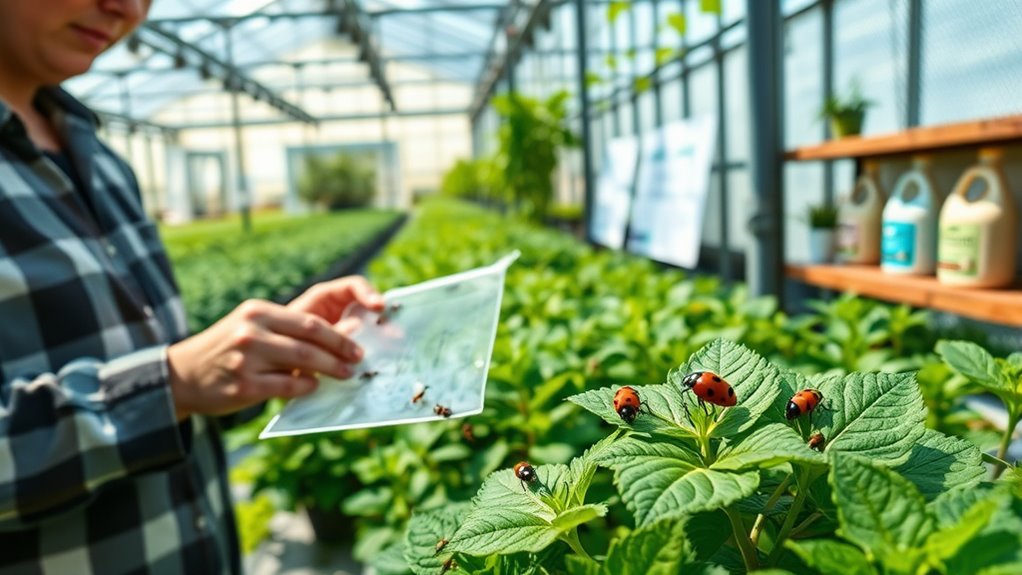
Implementing an Integrated Pest Management (IPM) program requires a strategic, multifaceted approach that combines various pest control methods tailored to your greenhouse environment.
Start by focusing on prevention through cultural practices, such as maintaining healthy plants and managing soil moisture. Form a team to assign responsibilities and guarantee ongoing training for identifying pests. Initial sanitation is crucial to reduce infestation risks. Monitoring for signs of distress in plants can help catch issues early. Additionally, using unique and wicked planters can enhance the aesthetics of your greenhouse while promoting plant health.
Incorporate mechanical strategies like physical barriers and regular removal of diseased tissues. Utilize biological controls, including beneficial insects and microbial agents. Additionally, integrating spray application of plant protection products can enhance overall pest management effectiveness. Consider incorporating protein-packed seeds like chia seeds into your greenhouse environment to bolster plant health and resilience.
To evaluate your IPM program, conduct regular scouting and keep detailed records of inspections and treatments. Establish economic thresholds to determine when to act, and continuously refine your strategies based on feedback and cost analyses.
Frequently Asked Questions
What Pests Are Most Commonly Found in Greenhouses?
In greenhouses, you’ll often encounter pests like aphids, whiteflies, and thrips.
These small insects can quickly multiply and damage your plants.
Fungus gnats tend to thrive in moist soil, while spider mites can cause significant harm with their sap-sucking habits.
Keeping an eye out for these common pests is essential to maintaining your greenhouse’s health.
If you notice any signs, it’s best to act quickly to prevent infestations.
How Can I Identify Beneficial Insects From Pests?
To identify beneficial insects from pests, look for distinct features and behaviors.
Beneficials like ladybugs and lacewings typically have vibrant colors and specific predatory habits. Pests, on the other hand, often cause visible damage to plants.
Understanding their life cycles will help you spot which insects are long-term allies versus those that multiply quickly. Observing their impact on your plants can also clarify their roles in your garden ecosystem.
Are There Specific Plants That Repel Pests Naturally?
Isn’t it amazing how nature offers its own pest repellents? Certain plants, like basil and mint, naturally deter pests with their strong scents.
Garlic’s pungency keeps aphids at bay, while catnip can even outshine DEET in repelling mosquitoes.
By incorporating these plants into your garden, you not only enhance its beauty but also create a healthy ecosystem that minimizes the need for chemical pesticides.
It’s a win-win for you and your plants!
How Often Should I Conduct Pest Monitoring?
You should conduct pest monitoring at least once a week, or even twice a week during the production season.
Regular inspections help you catch issues early and maintain healthy plants. Make sure to check sticky traps weekly, and ideally daily if possible.
Adjust your monitoring frequency based on the types of pests you encounter and their severity.
Keeping detailed records will help you track trends and make informed decisions moving forward.
What Are the Signs of a Pest Infestation?
When you’re checking for signs of a pest infestation, look for yellowing leaves, curling or distortion, and fine webbing.
Black fecal specks can indicate thrips, while sticky substances might come from sap-sucking pests.
You might notice wilting plants due to fungus gnat larvae damaging roots.
Keep an eye out for unusual spots or marks and any visible insects on your plants.
Early detection can help you manage the problem effectively.
Conclusion
Incorporating integrated pest management strategies into your greenhouse is like having a superhero team at your disposal, ready to defend your plants. By blending cultural, biological, physical, and chemical methods, you can create a balanced approach that minimizes pest issues while protecting the environment. Remember, the key to success lies in continuous evaluation and adaptation of your IPM program. With the right strategies in place, you’ll cultivate a thriving ecosystem that keeps pests at bay and your plants flourishing.
